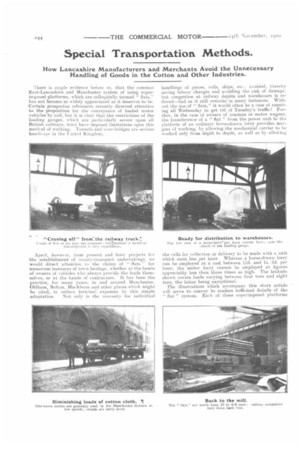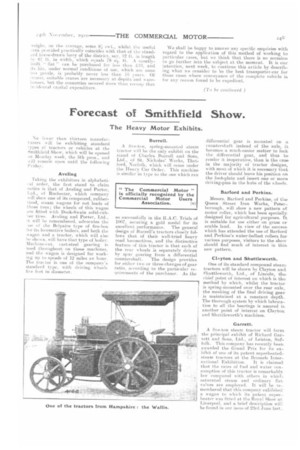Special Transportation Methods.
Page 14

Page 15

If you've noticed an error in this article please click here to report it so we can fix it.
How Lancashire Manufacturers and Merchants Avoid the Unnecessary Handling of Goods in the Cotton and Other Industries.
There is ample evidence before es, that the common East-Lancashire and Manchester system of using superimposed platforms, which are colloquially termed " flats," has not become so widely appreciated as it deserves to be. 'Certain prospectus references recently directed attention to the proposition for the oonveyance of loaded motor vehicles by rail, but it is clear that the restrictions of the loading gauges, which are particularly severe upon all British railways, must have imposed limitations upon this method of working. Tunnels and over-bridges are serious handicaps in the United K ingdorn.
Apart, however, from present and later projects for the establishment of county-transport undertakings, we would direct attention to the claims of " flats " for 'numerous instances of town haulage, whether at the hands of owners of vehicles who always provide the loads themselves, or at the hands of contractors. It has been the practice, for many years, in and around Manchester, Oldham, Belton, Blackburn and other places which might be cited, to reduce terminal expenses by this simple adaptation. Not only is the necessity for individual handlings of pieces, rolls, skips, etc., avoided, thereby saving labour charges and avoiding the risk of damage, but congestion at railway depots and warehouses is reduced—bad as it still remains in many instances. Without the use of " flats," it would often be a. case of requiring all Wednesday to get rid of Tuesday's traffic! Further, in the case of owners of tractors or motor wagons, the transference of a " flat " from the power unit to the platform of an ordinary horse-drawn lorry provides margins of working, by allowing the mechanical carrier to be worked only from depot to depOt, as well as by allowing the calls for collection or delivery to be made with a unit which costs less per hour. Whereas a horse-drawn lorry can be employed at a cost between lid, and is. Cxl. per hour, the motor lorry cannot be employed at figures appreciably less than three times as high. The latitude shown covers loads varying between four tons and eight tons, the latter being exceptional. The illustrations which accompany this short article will serve to convey to readers sufficient details of the " flat " system. Each of these superimposed platforms
iveighs. on the tlierage, some 8 ewt., wltils Je useful :Irea provided practically coincides with that of the standtrd horse-drawn lorry of the district, say, 12 ft. :n length 6.`, ft. in width, which equals 78 sq. ft. A stoutlyllat " can be purchased for less. than J_:10, and :k lile, under normal conditions of use, which are none is probably never less than 10 years. Of suitable cranes are necessary at depots and ware-I,ouses, but the economies secured more than recoup that :neidorit al capital expenditure.
We shall be happy to answer any specific enquiries with regard to the application of this method of working to particular cases, but we think that there is no occasion to go further into the subject at the moment. It is our intention, next week, to continue this article by describing what we consider to be the best transporter-ear for those cases where conveyance of the complete vehicle is for any reason found to be expedient.
(.lo be continued )






















